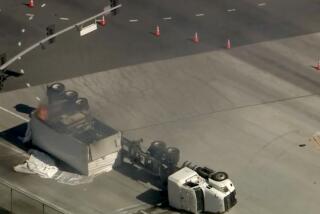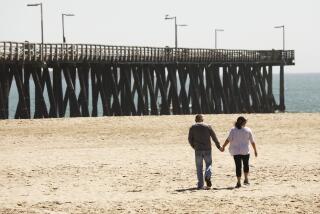Cleanup Starts on Freeway After Delays
A cleanup effort delayed for two days by technical snags and equipment problems got under way Tuesday afternoon at the site of a Southern Pacific freight train crash and toxic chemical spill at the small coastal community of Seacliff near Ventura.
The delay in beginning the cleanup was expected to keep a 10-mile stretch of the Ventura Freeway closed and 49 nearby homes evacuated until at least this afternoon, officials said.
Emergency officials said they postponed the cleanup of 440 spilled gallons of aqueous hydrazine, a jet fuel additive that is a suspected carcinogen, for reasons ranging from the discovery of unexpected explosion hazards to the realization that they had the wrong equipment for the job.
Ventura County Fire Department Assistant Chief Dick Perry acknowledged that the cleanup was running at least a day behind schedule but said there was no immediate environmental danger to the area.
“It’s a stable site in terms of the material not spreading outside the immediate area,” Perry said.
By Tuesday afternoon, toxic chemical handlers clad in white, airtight suits began vacuuming out 15 drums, each of which contained 55 gallons of hydrazine before being punctured in the crash. They placed 39 more drums, which were damaged but not punctured, into larger drums, sealed them and removed them from the ruptured 50-foot cargo container.
The hydrazine containers, carrying a chemical that causes nausea, lung and eye irritation and even death in cases of prolonged exposure, came by rail from Olin Chemical in Lake Charles, La., and were bound from Los Angeles to San Francisco for shipment overseas, said Mike Furtney, a spokesman for Southern Pacific. Furtney said he did not know the containers’ final destination.
Tuesday evening, workmen finally began applying a neutralizing spray to a tanker car and a quarter-acre of soil where the hydrazine had spilled, causing a toxic plume of gas to rise 150 feet into the air.
Investigators, cleanup crews and news reporters watched cautiously from railroad tracks about a third of a mile away, making sure the ammonia-and-hydrogen cloud did not blow toward them.
“This is why we don’t have the freeway open or let the residents back into the area,” county Fire Capt. Norman Plott said.
The delays in the cleanup operation were many, officials said.
Monday afternoon, the cleanup workers who were hired by Southern Pacific halted work just before they were to spray a chemical onto the hydrazine-soaked wreckage and soil to neutralize its toxic properties after discovering that they ran a risk of triggering an explosion.
The neutralizing chemical that the workers were planning to use is an 8% solution of swimming-pool chlorine that creates explosive hydrogen gas and small amounts of ammonia when mixed with hydrazine, Perry said.
Site supervisors for the cleanup contractor, OHM Corp. Environmental Services, determined that if they had sprayed the chlorine solution onto the drums the chemical reaction would have produced a cloud of hydrogen gas thick enough to present the risk of a massive explosion, Perry said.
After deciding to postpone their first cleanup plan, officials ordered a tank truck brought in later Monday afternoon so workers could vacuum out the contents of the drums.
But OHM supervisor Herbie Bart called a halt to that plan too, when he learned that the tank was made of carbon steel, rather than the stainless steel that he had ordered. The hydrazine could have eaten through the carbon steel and leaked out, Plott said.
The stainless-steel tank finally arrived about 9 p.m. Monday. But when it was backed up to the wreck, OHM workers realized that its hose would not reach the drums from its location at that time, Plott said.
By the time the truck could be repositioned and workers suited up, it was 2 a.m. Tuesday and county emergency officials called a halt to the cleanup for the night to allow the fatigued workers time to rest and regroup by the light of day, Plott said.
“These people are in very, very bulky suits that limit their movement,” Perry said. “They get fatigued when they make entry after entry into the site, and it takes a toll on them.”
By late Tuesday, three people at the crash scene had been sickened by fumes, but none required hospitalization, officials said. An elderly dog left by one of its owners at an evacuated home died, according to firefighters who had been feeding it since Sunday.
In addition to Ventura County emergency workers, hazardous material teams from Los Angeles and Santa Barbara counties were on the scene, spelling the local firefighters.
Despite repeated criticism of Southern Pacific from rail workers’ union officials for not having a caboose with observers on the train, Furtney said a caboose crew would not have spotted the danger before the derailment.
“There is no evidence a caboose would have helped,” Furtney said. “Cabooses are not used for observation so much as for the rest and relaxation of the train crews.”
The neutralization of the hydrazine was expected to be finished Tuesday night, officials said. That would allow Caltrans bridge inspectors to examine a concrete pillar supporting the freeway overpass at the crash site. Officials say the pillar may have been damaged by the derailment.
The southbound lanes of the freeway overpass, which was built in 1973, probably will be opened first once the cleanup is completed, and the northbound lanes will be opened as soon as possible after the support pillar is inspected, said Russell Snyder, a Caltrans spokesman.
The cleanup is costing Southern Pacific more than $50,000 per day, but the delay is unavoidable, said Jack Jenkins, a spokesman for the railroad.
Meanwhile, the Ventura County Board of Supervisors declared the crash site a local emergency, giving Sheriff John V. Gillespie temporary emergency powers.
The declaration gives Gillespie the power to commandeer resources from adjoining cities and counties, including hazardous material teams, equipment and helicopters needed in the cleanup. The declaration also allows the county to seek state and federal emergency funds, said Karen Guidi, program administrator for the county’s office of emergency services.
Rep. Robert J. Lagomarsino (R-Ventura) said Tuesday that he will testify today before a House subcommittee looking into the adequacy of federal regulations governing rail shipment of hazardous chemicals in light of the Southern Pacific wreck.
“We need to get to the bottom of this mess, find out why this accident occurred and how it can be prevented from happening again,” Lagomarsino said. “This is a potential time bomb. We’re fortunate that the derailment didn’t occur in a more populated area.”
Reed Smith, hazardous materials officer for California Department of Fish and Game, said the spill was not considered to be a threat to wildlife. “What we don’t know, however, is how far the hydrazine sunk down into the ground. Hydrazine is extremely hazardous to aquatic organisms.”
The chemical can kill marine life in concentrations of .33 p.p.m., Smith said. Once the hydrazine is neutralized, the remaining byproducts will pose no danger to fish and game because most of whatever lingers would evaporate, Smith said.
Times staff writers Joanna M. Miller and Hugo Martin contributed to this story.
More to Read
Sign up for Essential California
The most important California stories and recommendations in your inbox every morning.
You may occasionally receive promotional content from the Los Angeles Times.










